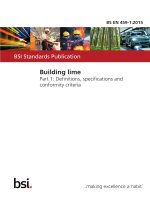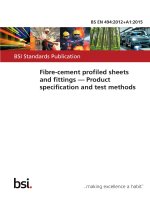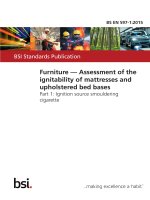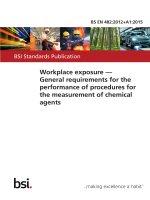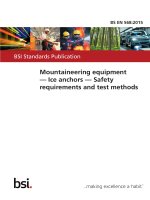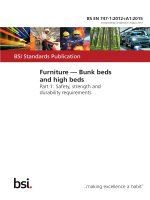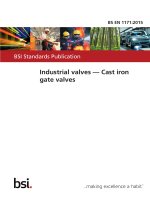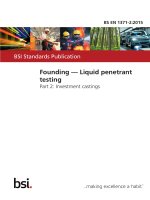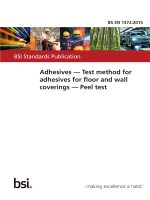Bsi bs en 16636 2015
Bạn đang xem bản rút gọn của tài liệu. Xem và tải ngay bản đầy đủ của tài liệu tại đây (1.25 MB, 38 trang )
BS EN 16636:2015
BSI Standards Publication
Pest management services
— Requirements and
competences
BS EN 16636:2015
BRITISH STANDARD
National foreword
This British Standard is the UK implementation of EN 16636:2015.
The UK participation in its preparation was entrusted to Technical
Committee SVS/14, Pest management services.
A list of organizations represented on this committee can be
obtained on request to its secretary.
This publication does not purport to include all the necessary
provisions of a contract. Users are responsible for its correct
application.
© The British Standards Institution 2015.
Published by BSI Standards Limited 2015
ISBN 978 0 580 83109 6
ICS 03.080.99; 65.100.01
Compliance with a British Standard cannot confer immunity from
legal obligations.
This British Standard was published under the authority of the
Standards Policy and Strategy Committee on 31 March 2015.
Amendments/corrigenda issued since publication
Date
Text affected
EN 16636
EUROPEAN STANDARD
NORME EUROPÉENNE
EUROPÄISCHE NORM
March 2015
ICS 03.080.99; 65.100.01
English Version
Pest management services - Requirements and competences
Services de gestion des nuisibles - Exigences et
compétences
Schädlingsbekämpfungsdienstleistungen - Anforderungen
und Kompetenzen
This European Standard was approved by CEN on 10 January 2015.
CEN members are bound to comply with the CEN/CENELEC Internal Regulations which stipulate the conditions for giving this European
Standard the status of a national standard without any alteration. Up-to-date lists and bibliographical references concerning such national
standards may be obtained on application to the CEN-CENELEC Management Centre or to any CEN member.
This European Standard exists in three official versions (English, French, German). A version in any other language made by translation
under the responsibility of a CEN member into its own language and notified to the CEN-CENELEC Management Centre has the same
status as the official versions.
CEN members are the national standards bodies of Austria, Belgium, Bulgaria, Croatia, Cyprus, Czech Republic, Denmark, Estonia,
Finland, Former Yugoslav Republic of Macedonia, France, Germany, Greece, Hungary, Iceland, Ireland, Italy, Latvia, Lithuania,
Luxembourg, Malta, Netherlands, Norway, Poland, Portugal, Romania, Slovakia, Slovenia, Spain, Sweden, Switzerland, Turkey and United
Kingdom.
EUROPEAN COMMITTEE FOR STANDARDIZATION
COMITÉ EUROPÉEN DE NORMALISATION
EUROPÄISCHES KOMITEE FÜR NORMUNG
CEN-CENELEC Management Centre: Avenue Marnix 17, B-1000 Brussels
© 2015 CEN
All rights of exploitation in any form and by any means reserved
worldwide for CEN national Members.
Ref. No. EN 16636:2015 E
BS EN 16636:2015
EN 16636:2015 (E)
Contents
Page
Foreword ..............................................................................................................................................................3
Introduction .........................................................................................................................................................4
1
Scope ......................................................................................................................................................5
2
Normative references ............................................................................................................................5
3
Terms and definitions ...........................................................................................................................5
4
Professional approach to pest management ......................................................................................8
5
5.1
5.2
5.3
5.4
5.5
5.6
5.7
5.8
5.9
5.10
5.10.1
5.10.2
5.11
5.12
Process flow of professional service ..................................................................................................9
Client Contact .........................................................................................................................................9
Inspect/Assess site ...............................................................................................................................9
Assess Infestation, Identify pests and conduct a root cause analysis......................................... 10
Client and site risk assessment ........................................................................................................ 10
Define field of legal application ......................................................................................................... 11
Define pest management plan ........................................................................................................... 11
Formal client proposal ....................................................................................................................... 12
Deliver the agreed service ................................................................................................................. 13
Manage site waste .............................................................................................................................. 13
Formal record, service report and client recommendation ............................................................ 13
Internal record ..................................................................................................................................... 13
Service report and recommendation ................................................................................................ 13
Confirm service effectiveness ........................................................................................................... 14
Monitoring ........................................................................................................................................... 14
6
6.1
6.2
6.3
6.4
6.5
Competence and requirements ......................................................................................................... 14
Competence ........................................................................................................................................ 14
Management of equipment ................................................................................................................ 15
Supply and use of pesticides ............................................................................................................ 15
Documentation and recording ........................................................................................................... 15
Insurance ............................................................................................................................................. 16
7
Subcontracting .................................................................................................................................... 16
Annex A (normative) Required competences ............................................................................................... 17
Annex B (informative) Field of application of the services .......................................................................... 28
B.1
General information ............................................................................................................................ 28
B.2
Protection of asset including wood, wood based products and Other Materials (including
Building Property and Bird Control) (top zone in Figure B.1) ........................................................ 28
B.3
Protection of plants and plant products (right zone in Figure B.1) ............................................... 29
B.4
Health Protection in Humans, Pets and livestock by Pest Management (bottom zone in
Figure B.1) ........................................................................................................................................... 29
B.5
Health Protection in Humans, Pets and Livestock by Disinfection (left zone in Figure B.1) ...... 29
Annex C (informative) List of common European pests .............................................................................. 30
Annex D (informative) Environmental Checklist ........................................................................................... 32
Bibliography ..................................................................................................................................................... 34
2
BS EN 16636:2015
EN 16636:2015 (E)
Foreword
This document (EN 16636:2015) has been prepared by Technical Committee CEN/TC 404 “Project
Committee - Services of pest management companies”, the secretariat of which is held by UNI.
This European Standard shall be given the status of a national standard, either by publication of an identical
text or by endorsement, at the latest by September 2015, and conflicting national standards shall be
withdrawn at the latest by September 2015.
Attention is drawn to the possibility that some of the elements of this document may be the subject of patent
rights. CEN [and/or CENELEC] shall not be held responsible for identifying any or all such patent rights.
According to the CEN-CENELEC Internal Regulations, the national standards organizations of the following
countries are bound to implement this European Standard: Austria, Belgium, Bulgaria, Croatia, Cyprus, Czech
Republic, Denmark, Estonia, Finland, Former Yugoslav Republic of Macedonia, France, Germany, Greece,
Hungary, Iceland, Ireland, Italy, Latvia, Lithuania, Luxembourg, Malta, Netherlands, Norway, Poland, Portugal,
Romania, Slovakia, Slovenia, Spain, Sweden, Switzerland, Turkey and the United Kingdom.
3
BS EN 16636:2015
EN 16636:2015 (E)
Introduction
In 2008, the World Health Organisation reported that the last sixty years had brought significant changes in
ecology, climate and human behaviour that favoured the development of urban pests (see Bibliography [7]).
The presence of such arthropods, rodents, other vertebrates and micro-organisms in proximity to humans
represents a significant hazard for public health. This arises from the possibility that pests can act as physical
and mechanical vectors for the introduction and spread of pathogens, diseases and possible allergens into
human and animal populations. These organisms can also cause direct and indirect damage to building
structures and their contents which can result in significant economic losses for commercial businesses, and
households. In addition, they potentially can cause deterioration in the quality of life, including a psychological
impact.
Arising from a need to address these concerns, the activities of disinfestation and the control of insects,
rodents, other vertebrates and any consequential disinfection of micro-organisms have been developed as a
service and are referred to collectively as the Pest Management industry.
The provision of pest control services is the subject of a number of EU Directives and Regulations, as well as
national regulation.
NOTE 1
These can be accessed on the Eurlex website (see [9]).
NOTE 2
The food industry uses professional pest control services and the providers of the services need to consider
the EU Regulations that apply and the types of control systems used in the food sector.
As these directives and regulations are being enacted, it is becoming clear that there is a need to unify and
further professionalize the European Pest Management industry. This does not only support the European
Commission’s goal to open up cross border trading but also serves to protect and reassure purchasers of pest
management services that suppliers operate to clear professional standards and thereby act safely, effectively
and within appropriate European and national regulations.
Within this context it has been suggested that there is a necessity to develop a single common essential
standard throughout Europe, the objective of which is to display to the clients that service providers following
this standard, offer a quality which
—
is recognized as being truly professional within all Europe;
—
will ensure that its operators are competent to sell and deliver the service they are offering by meeting
specified and validated minimum standards of knowledge, skill and practical competence;
—
will offer the best available advice on how to prevent pest problems in the client’s environment;
—
will offer effective and efficient service dealing with the root cause of the problem identified;
—
will provide a quality service recognized in Europe and will deliver safe services which minimize the risk
for clients and the general public, whilst minimizing possible negative impacts on the environment and
animal welfare.
The goal of every pest management activity is the effective and economical reduction or elimination of
damage caused by pests. The successful achievement of this goal is dependent on a partnership approach
between the service provider and the client.
To achieve this goal, the professional service provider conforms to the principles established by the World
Health Organization (WHO) in respect of Integrated Pest Management (IPM), which can include a
combination of habitat modification, biological control, physical control and chemical control.
Annex D includes an Environmental Checklist.
4
BS EN 16636:2015
EN 16636:2015 (E)
1
Scope
This European Standard specifies the requirements for pest management services and competences to be
met by professional providers of pest management services in order to protect public health, assets and the
environment.
This European Standard applies to those who have the responsibility for delivering pest management services
including the assessment, recommendation and subsequent execution of the defined control and prevention
procedures.
The requirements set out in this standard are designed to apply to any service provider whose activity falls
within this scope, namely the targeted field of application of suitable methods against pests.
This European Standard does not apply to delivering services in the area of:
—
field crop protection;
—
routine cleaning and disinfection associated with regular contract cleaning services.
2
Normative references
Not applicable.
3
Terms and definitions
For the purposes of this document, the following terms and definitions apply.
3.1
active substance
substance or a micro-organism that has an action on or against harmful organisms
[SOURCE: Regulation (EU) No 528/2012.]
3.2
administration
person who is part of professional service provider who is in direct contact with client
3.3
animal welfare
minimization of pain, suffering or distress to vertebrate species in compliance with relevant legislation
3.4
asset
anything tangible or intangible that is capable of being owned or controlled to produce value and that is held to
have positive economic value and represents value of ownership that can be converted into cash or other
human benefits
3.5
awareness
having cognizance (able to take note or identify) that something such as a fact, situation, condition or problem
exists and is relevant
3.6
biocidal product
substance or mixture, in the form in which it is supplied to the user, consisting of, containing or generating one
or more active substances, with the intention of destroying, deterring, rendering harmless, preventing the
5
BS EN 16636:2015
EN 16636:2015 (E)
action of, or otherwise exerting a controlling effect on, any harmful organism by any means other than physical
or mechanical action
substance or mixture, generated from substances or mixtures which do not themselves fall under the first
paragraph, to be used with the intention of destroying, deterring, rendering harmless, preventing the action of,
or otherwise exerting a controlling effect on, any harmful organism by any means other than physical or
mechanical action
Note 1 to entry:
A treated article that has a primary biocidal function will be considered a biocidal product.
[SOURCE: Regulation (EU) No 528/2012, modified — for editorial reasons, "any" was deleted at the very
beginning of each of the two definitions, the final Note 1 to entry was originally a normal paragraph and the
verb "shall" it originally contained was replaced with "will".]
3.7
biological control
use of natural substances or organisms to control and manage pests
EXAMPLE
Bacteria, viruses, pheromones, fungi, natural predators.
3.8
chemical control
use of active substances to eliminate, repel or inhibit the development of pests
3.9
competent person
<Pest Management> trained person who has the skill, knowledge, practical competence and responsibility
required to deliver professional pest management services
Note 1 to entry:
The required competences for each role are specified in Annex A.
3.10
contamination
presence of unwanted extraneous materials or microorganisms
3.11
disinfection
process of destroying, reducing or containing microorganisms
Note 1 to entry:
measure.
When this is part of a pest management activity or this activity is associated with a pest management
3.12
environment
surroundings (indoor and outdoor) or essential conditions in which an organism (person, animal or plant) lives
and operates and which can impact upon its survival, development and growth
3.13
habitat modification
man-made alterations to the dwelling or immediate environment of an organism that impacts on the activity
and/or the population of that organism
3.14
health protection
<Pest Management> promoting and protecting health and well-being by minimizing the health impacts of any
harmful organisms including pathogens and disease vectors
6
BS EN 16636:2015
EN 16636:2015 (E)
3.15
integrated pest management
IPM
careful consideration of all available pest control techniques and subsequent integration of appropriate
measures that discourage the development of pest populations and keep pesticides and other interventions to
levels that are economically justified and reduce or minimize risks to human health and the environment
[SOURCE: FAO]
3.16
material safety data sheet
MSDS
document provided by the manufacturer profiling the hazards associated with a substance or product
Note 1 to entry:
See Article 31 of Regulation 1907/2006 for requirements of Safety Data Sheets.
3.17
monitoring
process of maintaining pest specific regular surveillance over an agreed period of time and keeping a
systematic record of the progress towards or deviations from a defined level
3.18
non-target species
organism that is not the target of the control
3.19
pest
organism, which is harmful for humans, for humans’ activities, assets or products which they use or produce
or which is unwanted or harmful to animals or the environment
Note 1 to entry:
The grouping of pests is based on their general importance. Depending on the situation individual pest
species can belong to more than one group. See Annex C for a list.
3.20
pest infestation
presence of pests or signs of their presence
3.21
pest management
measures of all types which consist of damage assessment, pest infestation assessment, pesticide
application, documentation and prevention
3.22
pesticide
plant protection product or biocidal product used for the control of pests
Note 1 to entry:
Plant protection product is defined in Regulation (EC) No 1107/2009. Biocidal product is defined in 3.3
and in Regulation (EU) No 528/2012 (Article 3, 1 (a)).
3.23
physical control
managing pests using temperature, sound, electricity, air movement or humidity and mechanical methods
such as traps, fences, barriers
7
BS EN 16636:2015
EN 16636:2015 (E)
3.24
professional service provider
private or public enterprise, structure or organisation consisting of one or more persons specifically qualified,
certified or licensed and regularly trained, working according to a standard in which required levels of
knowledge and service approach are prescribed
3.25
professional user
person who is part of Professional Service Provider who is regularly trained and uses/applies pesticides in the
course of their activities
EXAMPLE
Example of professional user is technician or field agent.
3.26
public health
<Pest Management> protection of humans against the negative influences on health caused by pests
3.27
sales
part of the professional service provider who is in direct contact with the client and able to make a formal pest
management proposal for the client
3.28
service provider
private or public enterprise, structure or organisation consisting of one or more persons which provides (pest
management) services
[SOURCE: based on CEN Guide 15 definition, adapted to the pest management field.]
3.29
stored product pest
pest which develops in or on stored goods, causing damage making them unfit for consumption, further
processing or sale
3.30
technically responsible person
person within a professional service provider who is accountable for assuring the training and competence of
professional users and their compliance within the field to the defined service protocols (which include
inspection, identification of pests, risk assessment, service planning, evaluation of alternative service
approaches, defining the conditions under which control measures are applied and validation of service
effectiveness)
4
Professional approach to pest management
The professional service provider shall:
—
demonstrate that they have followed a process which is aligned with Figure 1;
—
demonstrate that this process is conducted by competent persons fulfilling a role as described in
Clause 5 and Annex A who shall implement their knowledge into their recommendations, proposals and
daily practices;
—
develop and present a pest management plan to the client which is mindful of the declared requirements,
impact and risks associated with the individual client’s specific environment and which encompasses the
processes of prevention and/or control as necessary in order to obtain both adequate sanitary and
environmental conditions and to avoid further proliferation of any infestation;
8
BS EN 16636:2015
EN 16636:2015 (E)
—
implement with the client the agreed control processes and shall be able to provide detailed records and
evidence of competence of each step within these control processes;
—
provide a report on the service conducted and assess to what extent the objectives identified in the pest
management plan have been achieved along with any recommendations for actions by the client in order
to assure maintenance of a sanitary environment post service.
NOTE
It is acknowledged that the way a service is commissioned can vary significantly from service provider to
service provider depending upon their business model (e.g. direct sales, web or phone enquiry, call centre, etc.), however
regardless of the client enquiry / sales process followed in order to demonstrate that a professional approach has been
adopted when considering and creating appropriate recommendations and proposals a professional service provide will
complete all the steps in Figure 1.
Figure 1 — Process flow for professional pest management services
5
5.1
Process flow of professional service
Client Contact
The professional service provider shall establish and record the declared requirements of the client taking
specific account of any relevant risk factors or client concerns which may impact upon the choice of service to
be proposed (e.g. nature of clients business, nature and value of assets impacted, location, etc.).
5.2
Inspect/Assess site
A thorough assessment shall be conducted by a competent person in order to determine whether there is pest
activity or whether the potential to support an infestation exists. The results shall be explained to the client
9
BS EN 16636:2015
EN 16636:2015 (E)
before any program of intervention is designed or implemented. The assessment shall provide a diagnosis of
the situation as requested by the client and shall include:
—
the detection and identification of the pest species;
—
an assessment of the extent and distribution of their presence;
—
an assessment of the local contributory factors which would favour their further proliferation;
—
identification of measures required to be taken to mitigate the risks of further proliferation of
contamination, infestation or re-infestation;
—
review and evaluation of the effectiveness of previous inspections, treatments and interventions.
Where this activity is conducted as part of a regular service contract and where no pest infestation is identified
the service activity shall move to monitoring.
The service provider shall record all inspections in accordance with any agreed contract and in compliance
with 5.1.
5.3
Assess Infestation, Identify pests and conduct a root cause analysis
When a pest activity is detected, a thorough assessment shall be conducted by a competent person fulfilling a
role as defined in Annex A and Clause 6. The results shall be recorded and explained to the client before any
program of intervention is designed or implemented; the assessment shall provide a diagnosis of the situation
and at a minimum shall include:
—
the detection and identification of any pest species as well as an assessment of the extent and
distribution of their presence;
—
the identification of the potential for, or the presence of, pest species/organisms;
—
an assessment of the local contributory factors which would favour their further proliferation;
—
the identification of preventive measures, including client corrective actions required to mitigate the risks
of further infestation; a distinction shall be made in the recommendations where the client is accountable
for taking a corrective action or modifying local practices;
—
a review and evaluation of the effectiveness of previous inspections, treatments and interventions.
Particular note shall be made and recorded of situations where the client has failed to act upon previous
recommendations designated as within their accountability and the potential impact on sustaining the
current infestation.
Where the presence of pest organisms is identified, the professional service provider shall make all
reasonable endeavours to establish and trace the possible sources of the infestation; these findings shall be
taken into account both within any formal recommendations and in design of any preventive and treatment
strategies.
5.4
Client and site risk assessment
Business sectors need to comply with varying third party specifications and a professional service provider
shall be able to appreciate that these factors contribute to their client’s requirements. The service provider
shall define their response and recommendations based upon any potential threat to health, assets and the
environment identified within the client’s own environment.
When considering alternative treatment strategies (see (6) of Annex A) the pest management company or
organisation shall consider:
10
BS EN 16636:2015
EN 16636:2015 (E)
—
any implications arising from the requirements of the nature and structure of the premises, environment
and location, activities being performed at the site;
—
the client’s attitude to risk (i.e. the nature of the pest organisms, the likelihood of presence and/or
proliferation and a realistic assessment of the potential consequences any such presence would have on
the client);
—
potential impact of the intervention on the environment and non-target species.
5.5
Define field of legal application
The technically responsible person shall establish formally which regulations are applicable and then select an
appropriate control strategy to be included in the pest management plan for the client.
NOTE
5.6
Different control scenarios are subject to different European regulations (see Annex B).
Define pest management plan
Following the fulfilment of the requirements in 5.1 to 5.5 the professional service provider shall propose a pest
management plan. The plan shall define the appropriate strategy, a timetable of actions and take into account
the type of client / industry and any relevant local site factors.
In addition the client shall be advised of any area or practice of their operation that could impact on the
proposed strategy. Likely scenarios could include the following:
a)
during the assessment of the site, no presence of pests was found and the internal environment was
correct (i.e. the conditions are not favourable for the proliferation of pests). Periodic monitoring shall be
continued in order that the results of the diagnosis are maintained;
b)
during the assessment of the site, no presence of pests was found, but the internal or local external
environment is such that it could possibly facilitate establishment of an infestation. The professional
service provider shall consider and advise on:
c)
1)
methods concerning the structure and construction;
2)
the prevailing hygiene/sanitary conditions and environment;
3)
actions to train and develop client’s behaviour or practices;
4)
direct control methods over pests in the immediate external vicinity.
during the assessment of the site, the presence of pests was found. The activities indicated in point b
above shall be used, and in addition, methods of direct control over the pest within the interior of the site.
When defining appropriate methods of control, the principles of integrated pest management shall be followed
and include consideration of the following strategies or rational combinations thereof as appropriate for each
pest species identified:
—
habitat modification;
—
biological control;
—
physical control;
—
chemical control.
When selecting the control methods consideration shall be given to:
11
BS EN 16636:2015
EN 16636:2015 (E)
—
risk to local environment;
—
potential to contaminate environmental compartments e.g. agricultural soil or surface waters;
—
potential for primary and secondary poisoning of non-target animals.
5.7
Formal client proposal
In cases where the original sales process did not involve a direct visit to site, the service provider shall verify
any pre-information before proceeding with service. The professional service provider shall present the most
relevant findings of 5.2 to 5.6 in a logical and sequential way to the client and shall detail the logic on which
the proposed pest control service strategy is based. It shall comprise, as appropriate, the following elements:
a)
risk of infestation on the site (existence and likelihood of access);
b)
identification and information on the species of arthropods, rodents and other vertebrates that have been
detected in the survey;
c)
likely origin of the stated species and location within the site;
d)
assessment of the level of contamination/pest infestation and the extent to which it is distributed across
the client site;
e)
advice to the client of the potential risks associated with the presence of the infestation;
f)
factors that influence the access or proliferation of the pests including local site conditions, structures,
sanitary hygiene, work practices; this ensures correct information is provided to the owner of the site;
g)
a description of the proposed control strategy and details of the methods of intervention, including, where
needed, additional steps to restore sanitary conditions on site;
h)
a description of the proposed preventive strategy, with details of the methods and client’s responsibility
for follow-up the respective duties according to service provider recommendations;
i)
where necessary, an assessment of the need to obtain external assistance (for example: requirement for
municipal services to access an external sewer);
j)
a risk assessment of the implications of the treatment strategy and how this will be deployed;
k)
other information of technical interest that is relevant to specify the situation at this stage, to determine
any urgent environmental correction measures, technical control operations with reference to future
actions, including preventive actions, to be conducted by the client or service provider;
l)
a quotation for the client to sign his acceptance and approval to proceed.
The professional service provider shall record and present items b), g), k) and l) in writing and, as appropriate,
should record and present the other items.
In cases where there is no ongoing contract and the service requested by the client is not recurring the
requirement for a formal document may be limited to g) and l).
In the case that following an exchange of information between the service provider and the client and where
no contract is agreed the service provider may not provide the formal proposal.
The formal client proposal shall include provision to follow up to ensure the service has been effective and that
there is no further treatment is required.
12
BS EN 16636:2015
EN 16636:2015 (E)
5.8
Deliver the agreed service
The professional service provider shall deliver service as follows:
—
selecting the appropriate method of control including any active ingredient and formulation where
required (always following the label required);
—
using a suitable method of application;
—
correct storage and transportation.
5.9
Manage site waste
The professional service provider shall manage and dispose of waste safely and in a manner that will avoid
adverse impacts on the environment, people and non-target species. The service provider shall act in
accordance with relevant local and European legislation and codes of practice.
NOTE
For the purposes of this standard waste includes animal carcases, bird excrement, materials and equipment
that have no useful purpose and require disposal (to include but not restricted to spent baits, traps, pesticide containers,
packaging and light bulbs).
5.10 Formal record, service report and client recommendation
5.10.1 Internal record
The professional service provider shall retain on file a record of the pest management plan and service
delivered which shall include (see 5.1), but is not limited to the following:
—
client name and address serviced;
—
date, time and type of service delivered;
—
name of the product employed, the quantity used, the method and area of application;
—
details of any corrective/preventive actions recommended to the client;
—
details on progress (or otherwise) of any previous recommendations made to the client;
—
identification of the professional user.
5.10.2 Service report and recommendation
The professional service provider shall issue a report to the client at agreed intervals. The report shall include
but is not limited to the following:
—
identification of the service provider;
—
client name and address;
—
confirmation that the agreed service has been completed and reports any deviation;
—
date, time and type of service delivered, including a record of the products used and area of the
application;
—
any recommendations of actions to be taken by the client to prevent recurrence
—
re-entry period into the treated area, if applicable.
13
BS EN 16636:2015
EN 16636:2015 (E)
5.11 Confirm service effectiveness
The professional service provider shall demonstrate service effectiveness by confirming that the results
achieved are in accordance with the objectives in the plan agreed with the client. This may also include
additional recommendations for actions to be completed by the clients or the professional service provider.
Following the successful completion of the service the file is closed for single jobs or moved into monitoring or
regular service contracts.
5.12 Monitoring
For regular service contracts, the professional service provider shall define and recommend to the client an
appropriate frequency of surveillance visits (see 5.6) which assures the protection of the client’s assets.
The professional service provider shall record the outcome of each visit and, where evidence of pest activity is
discovered, propose suitable interventions in accordance with the process flow of professional services.
6
Competence and requirements
6.1
Competence
6.1.1 As a general requirement, personnel having the roles identified in Annex A shall be able to
demonstrate sufficient competence in literacy and numeracy to enable them to be able to fulfil their
responsibilities including reading, writing, calculating and communicating verbally with clients and being able
to interpret client requirements and technical requirements specified in labels, MSDS sheets and service
protocols.
Annex A provides details of the competencies necessary for each role in a professional service provider.
6.1.2 The professional service provider shall have in its permanent staff (i.e. not occasional), a technically
responsible person with accountability for supervising the attainment and maintenance of practical and
theoretical knowledge along with the necessary technical skills for the performance of pest control activities
and their verification within the company.
6.1.3 The professional service provider shall ensure that the training activities and professional experience
are documented and updated continually in order to demonstrate the adequacy of its competence in terms of
the range of pests serviced and the methods of pest management used. This document that shall be available
upon request.
6.1.4 Prior to commencing delivery of any service in their sector, staff shall participate in specific training
and qualifying courses which include a final formal evaluation to verify their comprehension and achievement
of competence levels described in Annex A.
6.1.5 Where staff undergo training to fulfil one of the roles described in Annex A, a training log shall be
maintained to show what training has been completed and the results of the assessment of competence. The
record shall be retained in the staff training records.
6.1.6 The professional service provider shall ensure that people who are in training to fulfil a role defined
within Annex A shall work under direct supervision of the technically responsible person or the designated
competent person.
6.1.7
Staff shall have knowledge of the impact of available strategies on target and non-target species.
6.1.8 The professional service provider shall ensure that the knowledge and skills of their staff continues to
be current and of relevance, by establishing a system of continuing professional development and training for
the technically responsible person and each professional user. This update shall be taken when it is
considered necessary by the technically responsible person and shall be reviewed at least every three years.
14
BS EN 16636:2015
EN 16636:2015 (E)
6.1.9 At least once per year professional competence shall be demonstrated by each professional user
through assessment by the technically responsible person or their nominee using a combination of training
records, site visits and personal observation, and be recorded formally. Where there has been a shortfall, the
technically responsible person shall be able to demonstrate that a corrective intervention has been made and
recorded in the professional user’s personal file or training log.
6.2
Management of equipment
The technically responsible person shall have a detailed list of the vehicles and equipment used in the delivery
of the service with related documentation which includes an adequate maintenance schedule. The
maintenance schedule shall include the calibration and adjustment of those items that require it.
6.3
Supply and use of pesticides
6.3.1 The technically responsible person shall give preference to methods and interventions in accordance
with the principles of Integrated Pest Management (IPM).
6.3.2 The technically responsible person shall ensure that only products approved by the competent
authorities are used by the professional users.
6.3.3
When selecting pesticide(s) for use consideration shall be given to:
—
aspects concerning the efficiency;
—
effectiveness (including the consideration of resistance management) and selectivity of the product;
—
environmental and human impact;
—
animal welfare impact.
6.3.4
The pesticides shall only be used following the instructions stated in the product label.
6.3.5 The technically responsible person shall provide information to the professional user, to advise the
client about risks with respect to the products used, which can include potential impact on persons, goods,
and non-target species that may be exposed.
This shall include information about any re-entry restriction period.
6.3.6 The technically responsible person shall ensure that all precautions are taken to prevent accidental
spillages or contact with non-target species. In the event of a spillage or contact with a non-target species an
appropriate clean up protocol shall be used and a record of the event shall be maintained.
6.4
Documentation and recording
6.4.1 A procedure shall be documented for each type of service to be provided by the professional service
provider.
6.4.2
The professional service provider shall:
—
document the type of service that is to be provided to the client and keep on file for a minimum of one
year or more in accordance with client and legal requirements;
—
record evidence of activities performed and results achieved to include date of intervention, pest,
infestation, techniques and pesticides used and any other relevant information;
15
BS EN 16636:2015
EN 16636:2015 (E)
—
provide information on the specific pest management plan based on the risk assessment necessary to
establish the agreed control processes and include the responsibilities, rights and duties of each of the
parties to the contract;
—
complete a formal review and assessment of the results including any further recommendations for the
client.
6.4.3 During the delivery of services, the professional user shall prepare accurate records when on site to
include information on:
—
the products, the quantities used and their active ingredients;
—
recommendations to be adopted by the client before, during and after the intervention, to ensure a safe
and effective service for client, non-target species and the environment.
6.4.4
Where the services provided require continuous monitoring or control the records shall include:
—
the actual plan stating the location and other information of control points;
—
planned monitoring schedule.
6.4.5 Assessment of the investigation, if necessary root cause of pest infestation and proposals/measures
to be carried out by the professional service provider or the client; e.g. additional treatment, additional
monitoring systems, improvement of structures, processes, handling.
6.4.6
The professional service provider shall provide documentation:
—
to inform and educate the clients;
—
that demonstrates the efficacy of the services provided;
—
that specifies any actions that are necessary by the client in order to prevent further infestation.
6.5
Insurance
The service provider shall protect the interests of their clients and members of the public by having an
appropriate level of public liability and professional indemnity insurance.
7
Subcontracting
When the professional service provider subcontracts the provision of pest management services to a third
party, it shall remain responsible for ensuring that those services are provided in compliance with the
requirements of this European standard.
16
BS EN 16636:2015
EN 16636:2015 (E)
Annex A
(normative)
Required competences
Table A.1 specifies the competences (based on skill, knowledge and understanding) required by an individual
fulfilling specific roles in the delivery of professional pest management services.
A single individual may fulfil multiple roles in the offering or delivery of services.
Table A.1 — Required competences
Task
N.
Required Competence
Administration
Client
Sales
(2)
Assess
Site
Professional
user
(1)
First Contact:
Problem
definition
Client context
Location
Roles
Technically
Responsible
person
The person carrying out this role
shall be able to…
1.1
Define client type, pest
problem and associated
risk/action priority for
client type and its specific
business requirements
Yes
No
Yes
Yes
1.2
Collect
relevant
information
concerning
pests (activity, layout,
environment,
design,
previous pest, treatment,
risk factors)
Yes
Yes
Yes
No
1.3
Pass to the technically
responsible person all
information in accordance
with the risks
—
Yes
Yes
Yes
2.1
Describe the relevant
biology and behaviour of
public health pests and
any other pests against
which service is provided
(including
life
cycle,
habitat
and
food
preferences)
Yes
Yes
Yes
Awareness
17
BS EN 16636:2015
EN 16636:2015 (E)
Task
N.
Required Competence
18
Professional
user
Sales
Administration
Roles
Technically
Responsible
person
The person carrying out this role
shall be able to…
2.2
Detect and identify the
common pest species
associated with public
health risks and the pests
against
which
their
service
is
provided
(including indicators or
non-target species)
Note: Annex C gives an
indication of the common
European pests
Yes
Yes
Yes
No
2.3
Estimate the level of
infestation and define the
extent of its distribution
and risk to the client’s
environment
Yes
Yes
Yes
No
2.4
Identify and assess the
factors that might impact
on control or influence the
entry, distribution and
proliferation
of
pest
infestation at the client
location,
building
structure
and
environment
Yes
Yes
Yes
No
2.5
Describe the purpose and
correct use of inspection
tools and methods
Yes
Yes
Yes
No
2.6
Explain
appropriate
control methods and their
potential
impact
on
humans, target and nontarget species and plant
organisms
within the
context of the client’s
environment
Yes
Yes
Yes
No
2.7
Identify
preventive
measures required to be
taken to mitigate the risks
of further proliferation of
contamination
or
reinfestation
Yes
Yes
Awareness
No
2.8
Evaluate
the
effectiveness of previous
inspections,
treatments
and interventions
Yes
Yes
Yes
No
BS EN 16636:2015
EN 16636:2015 (E)
Task
N.
Required Competence
Professional
user
Sales
Administration
(3)
Root
Analysis
3.1
Communicate the likely
root
causes
of
infestations, based on the
information from Task 2
and, where necessary,
recommend
the
application
of
further
investigations
Yes
Yes
Awareness
No
4.1
Conduct and document
an operational health and
safety risk assessment
for the services to be
provided on the site
Yes
Yes
Yes
No
4.2
Explain to the client the
implications to health and
safety of site location
factors, including moving
vehicles,
electricity,
confined
spaces,
proximity of risk area to
other work areas
Yes
Yes
Yes
No
4.3
Identify
the
potential
commercial impact of
different pests on the
client’s business and
explain the trade-offs
between efficacy, speed
and toxicity of alternative
approaches to control.
Yes
Yes
Yes
No
4.4
Describe
the
key
requirements of local and
European
safety,
environmental,
animal
protection and animal
welfare
legislation/regulations
relevant to the pest
management
services
that they offer
Yes
Awareness
Awareness
No
4.5
Identify
on-site
constraints
(access,
working from height, nontarget species, site audit
requirements, regulations
applying to the site or
client) which will impact
upon pest management
protocols
Yes
Yes
Yes
No
Cause
(4)
Client & Site
Risk Analysis
Roles
Technically
Responsible
person
The person carrying out this role
shall be able to…
19
BS EN 16636:2015
EN 16636:2015 (E)
Task
N.
Required Competence
20
Professional
user
Sales
Administration
(5)
Define field
application
Roles
Technically
Responsible
person
The person carrying out this role
shall be able to…
4.6
Identify potential routes
for contaminating the
environment
and
recommend appropriate
preventive interventions
Yes
Yes
Yes
No
4.7
Describe
pre-treatment
site preparation including
any
necessary
exclusions, warnings or
special measures
Yes
Yes
Yes
No
4.8
Describe post-treatment
site clean-up, including
any
necessary
exclusions, warnings or
special measures
Yes
Yes
Yes
No
4.9
Use
equipment
for
working
at
heights
correctly
Yes
Yes
Awareness
No
4.10
state the impact of the
selected control method
on animal welfare of
target and non-target
species
Yes
Yes
Awareness
No
4.11
Determine and correctly
state
the
client’s
expectations of the pest
management
process,
including
acceptable
levels of pests that will be
tolerated
Yes
Yes
Yes
No
5.1
Select
the
correct
products and tools for
specific
pest
management jobs and
correctly
explain
the
selection,
taking
into
account the customer’s
attitude to risk, their
location
and
the
environment of the job
Yes
Yes
Awareness
No
5.2
Explain how specific pest
management jobs shall
be carried out in order to
comply with legislation
applicable to the specific
field
Yes
Yes
Yes
No
of
BS EN 16636:2015
EN 16636:2015 (E)
Task
N.
Required Competence
Professional
user
Sales
Administration
(6)
Define
alternative pest
management
strategies
including
monitoring
Roles
Technically
Responsible
person
The person carrying out this role
shall be able to…
6.1
Describe the use of
physical
methods
of
insect
killing
(temperature, controlled
atmosphere) in different
environments
and
products
Yes
Yes
Yes
No
6.2
Describe the use of
mechanical systems and
products
which
can
facilitate the removal,
and/or
prevent
the
entry/access
of
nontarget animals and target
pests into the building
and surrounding site
Yes
Yes
Yes
No
6.3
Describe the use of
sustainable
products
including procedures and
requirements for pest
species
control
with
minimum chemical impact
Yes
Yes
Yes
No
6.4
Describe the use of
pheromones, attractants
and traps to catch and
continuously monitor both
the presence and activity
of the targeted pests and
non-target animals
Yes
Yes
Yes
No
6.5
Describe criteria for the
placement of traps for
relevant pest species in
different
environments,
products and materials
Yes
Yes
Yes
No
6.6
Correctly use instruments
and safety materials in
the installation of traps
and
accessories
in
different environments
Yes
Yes
No
No
21
BS EN 16636:2015
EN 16636:2015 (E)
6.7
Detect
and
identify
common vertebrate and
invertebrate
species
(including indicators and
non-target species) in
traps in different types of
location
Roles
Administration
The person carrying out this role
shall be able to…
Sales
Required Competence
Professional
user
N.
Technically
Responsible
person
Task
Yes
Yes
Yes
No
NOTE
Annex C gives
an indication of the common
European pests.
(7)
Prepare a pest
management
plan for the client
22
6.8
Organize a continuous
work programme with
high level of attention to:
• monitoring
activities
• the management
of
technical
information
• The elaboration
and collation of
relevant data and
its
quick
communication
and transmission
to the client
Yes
Awareness
No
No
6.9
Recommend and justify,
based on 6.1 to 6.8, the
best
combination
of
methods to be applied to
the client’s situation
Yes
Yes
Yes
No
6.10
Explain
environmental
management factors that
should contribute to an
integrated
pest
management programme
specific to the target
pests
Yes
Yes
Yes
No
7.1
Communicate with clients
and colleagues clearly
and effectively in writing
and
orally,
including
presenting
pest
management plans and
professional reports
Yes
Yes
Yes
Yes
BS EN 16636:2015
EN 16636:2015 (E)
Task
N.
Required Competence
Professional
user
Sales
Administration
(8) Maintenance,
transport.
Storage
and
calibration
of
equipment
Roles
Technically
Responsible
person
The person carrying out this role
shall be able to…
7.2
Present details of pest
identification,
risk
of
infestation (existence of
pests and their possibility
of future access), likely
origin, distribution and
extent of the population
Yes
Yes
Yes
No
7.3
Identify factors that favour
the access or proliferation
of the pests, including
preventive measures and
external assistance.
Yes
Yes
Yes
No
7.4
Plan the use of physical,
physical-chemical and/or
biological measures(for
chemical treatments to
include the choice of
pesticides,
application
technique,
safety
procedures)
Yes
Yes
No
No
7.5
Define a formal client
proposal
Yes
No
Yes
No
8.1
Describe
health
and
safety
procedures
including all associated
rules
and
the
use
personal
protective
equipment that may be
required for the protection
of life and health
Yes
Yes
Awareness
No
8.2
Demonstrate the correct
storage,
carriage,
handling and use of
equipment
Yes
Yes
No
No
8.3
Describe
the
correct
storage, use, transport,
handling and disposal of
hazardous
substances,
their possible adverse
effects and protective
measures
Yes
Yes
No
No
8.4
Describe the different
equipment that is used
depending on the type of
treatment being provided
Yes
Yes
Awareness
No
23
